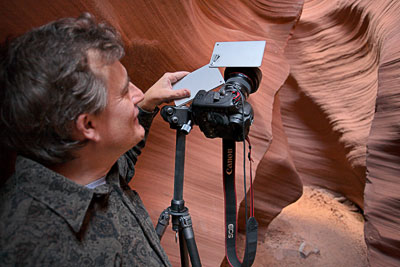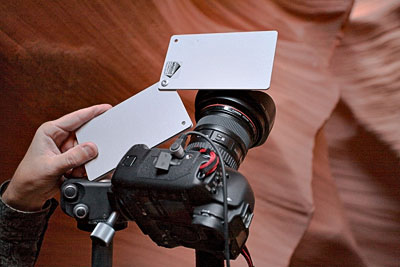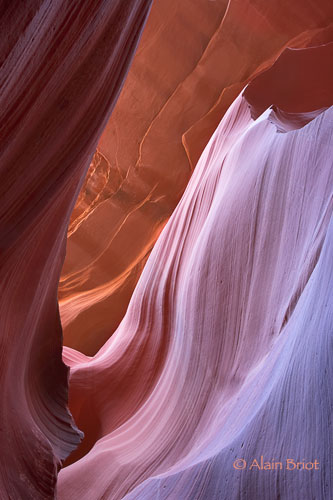
|
Using WhiBal as a Lens Shade
Other essays in this series

Using WhiBal as a lens shade in Antelope Canyon
Photograph by Luc Schoonjans
The double life of WhiBal
I recently reviewed WhiBal in an other essay. WhiBal is a very practical accessory made by my friend Michael Tapes. WhiBal is designed to help you color balance your photographs.
However, during the 2005 Digital Photographers Summit, I found a second use for WhiBal: as a lens shade. I was photographing in Antelope Canyon, a slot canyon which is naturally deep and dark. In these conditions, flare commonly occurs when you shoot upwards, because the light of the sky is so much more intense than the ambient light in the canyon.
Flare will ruin your photographs. With telephoto lenses the built-in lens shade does a pretty good job because it extends several inches in front of the lens. But with wide angles, which I was using on this day, the built in lens shade is really more a protection against bumping the lens on the canyon walls than an actual remedy to lens flare.
Whenever possible I use my hand to shade the lens. This works OK when I shoot level. But when I shoot upwards, and when the exposure is several seconds long, a regular occurence in Antelope Canyon where exposures of a minute or more are common, using my hand is quite unpractical. Over the course of the exposure my hand invariably moves, and by the time the exposure is over and I look at the photo on the LCD screen, I can see that it has become part of the photograph.
Such was the case this year in Antelope Canyon. So I looked into my camera bag for a solution. I tried everything. What I found that worked perfectly was WhiBal, the large version that is.

Close up showing the exact position of WhiBal on the tripod & camera
(Canon 1DsMk2 with 17-40, RRS BH 50 and Gitzo 2228)
Photograph by Luc Schoonjans
A photograph is worth a thousand words, so I asked Luc Schoonjans, a friend and Digital Summit participant, to take a couple of photographs of me using WhiBal as a lens shade. Basically, I propped the large WhiBal onto the ballhead on my tripod, extended one of the cards, and rested this other card onto my camera. All I had to do then was make sure I didn't move so as to not induce vibration to the tripod and camera. This was easy. If I had a bit of velcro I could have placed one on WhiBal and one on the camera, or the tripod, and made this assembly self-supporting.
The great thing with using WhiBal as a lens shade is that it is made of non-reflective materials. So, you are guaranteed that no light will bounce from WhiBal into your lens. This is an important consideration in a place like Antelope Canyon where nearly all the ambient light is bounced light.

Waves of Sand
Photograph by Alain Briot
Here is the photograph I was taking in the "WhiBal at work" images. As you can see, it was well worth the trouble and flare would have completely ruined the delicate tones in this image.
About Antelope Canyon
The first time I went to Antelope Canyon was in 1986. Since then I have gone back over 100 times. I keep going back over and over again, and people ask me frequently if I continue to see new images there. Fact is, I do. So much so that during my most recent visit, which was just a couple weeks ago during the Digital Summit, I created several portfolio-quality images, images that I had not seen before. The one featured on this page is only one of them.
For those who want to discover Antelope Canyon with me, and benefit from my 20 years of experience photographing there, Natalie and I are offering an Antelope Canyon Workshop in April 2006. You can find all the information about this exciting workshop on this page.
And of course, you can get your own WhiBal from Michael Tapes at RawWorkflow.com. Tell Michael I sent you ;- )
Alain
Design, concept, and photographs Copyright © Alain Briot 2005
All rights reserved worldwide
.
|
 |
|
|
|
|